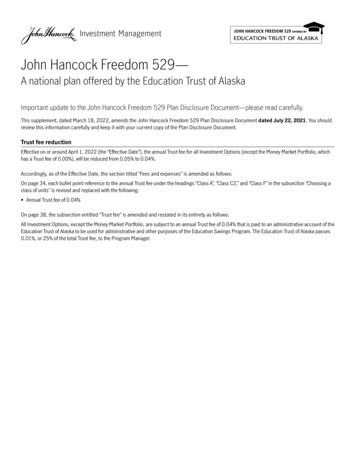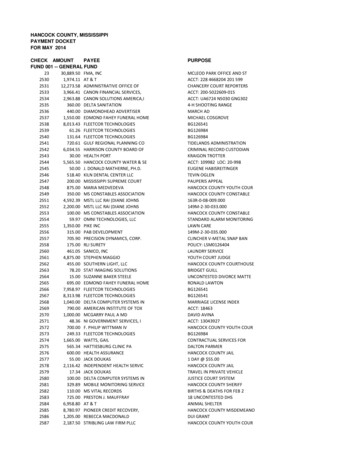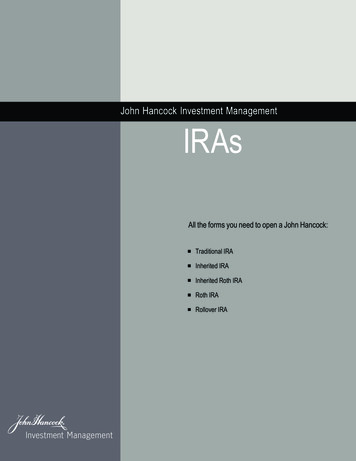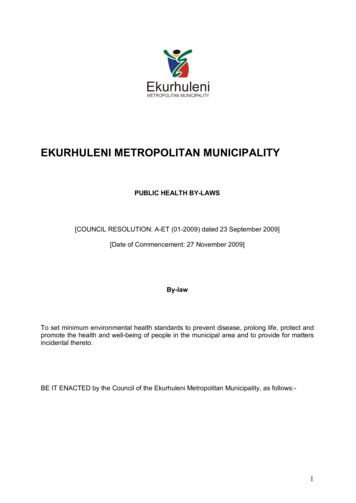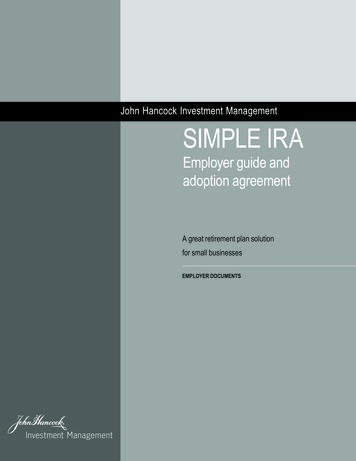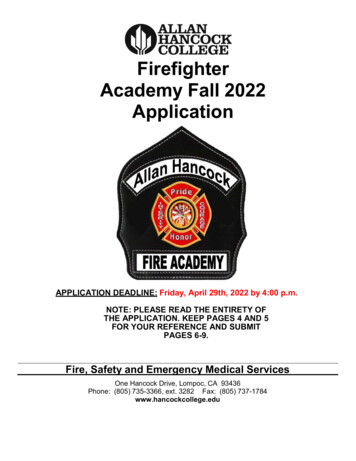
Transcription
Workforce Development PlanHancock Public HealthAdopted on02/10/2017
Hancock Public Health Workforce Development Plan1 Page
Signature PageThis plan has been approved and adopted by the following individuals:2/10/2017Karim Baroudi, MPH, RS, REHS-Health ption of ChangePagesAffectedReviewed orChanged byFor questions about this plan, contact:Lindsay Summit, cock Public Health Workforce Development Plan2 Page
Table of ContentsTraining and development of the workforce is one part of a comprehensive strategy towardagency quality improvement. Fundamental to this work is identifying gaps in knowledge, skills,and abilities through the assessment of both organizational and individual needs, and addressingthose gaps through targeted training and development opportunities.This plan serves as the foundation of Hancock Public Health’s ongoing commitment to thetraining and development of its workforce.TopicAgency ProfileWorkforce ProfileCompetencies & Education RequirementsTraining NeedsWorkforce Development GoalsCurriculum & Training ScheduleImplementation & MonitoringAppendicesAppendix A: Personal/Professional Developmental PlanAppendix B: Workforce Development Assessment Executive ReportAppendix C: Cultural and Linguistic Assessment Executive ReportAppendix D: Training Evaluation TemplateAppendix E: Sign in SheetHancock Public Health Workforce Development PlanSee Page1458111221ABCDE3 Page
Agency ProfileMission &visionOur Mission:“We exist to improve ourselves and our communities. Promote public healthand the prevention of disease. Protect people and the environment.”Our Vision:Hancock Public Health WillBe: An accredited leader in public health by 2020Empowering employees through a collaborative and nurturingenvironmentInnovators in population health and stewards for the futureDo: Serve and enhance the lives of citizens of Hancock CountyForge new alliances in the pursuit of improved health outcomes, andcontinue to foster existing community partnershipsHave: Financial stability A recognized central location that provides optimal client satisfactionby 2018.Core valuesHancock Public Health maintains the following core values: Accountability-We believe to achieve excellence, each member ofour team must take ownership in its success and that we must beresponsible to the community for implementing programs andstrategies that improve the overall health of our population.Integrity-We believe our integrity reflects our ability to be honest inour word; timely in our commitments; comprehensive in our workQuality-We will strive to meet recognized performance measureswhile always seeking new opportunities to improve our service andquality of work.Teamwork-We believe people are our most valuable resource. Wemust establish a culture of trust, cooperation and teamwork to allowthem the ability to perform at their highest potential possible.Hancock Public Health Workforce Development Plan1 Page
StrategicprioritiesHancock Public Health 2016-2019 Strategic Health Priorities: Reduce adult, youth and child obesity Reduce adult, youth and child substance abuse Increase adult, youth and child mental health Decrease youth and child bullying Improving family functioningHancock Public Health Strategic Position is centered around the areas of 1)Financial Vision, 2) Customer Strategy, 3) Process Improvement and 4)People Investment.GovernanceThe Board of Health is the governing body of HPH. The District AdvisoryCouncil appoints 7 members to the Board of Health. The District AdvisoryCouncil consists of the chairman of the board of trustees from each township,the mayor from each village, a representative of the Board of CountyCommissioners and the Findlay Mayor. The Health Commissioner is thesecretary to the Board of Health.In accordance with the Ohio Administrative Code 3701-36-03 (7) each Boardof Health member is required to complete two hours of continuing educationhours each year.LearningcultureThe HPH learning philosophy is to support and sustain a capable andqualified workforce. HPH supports a culture that encourages and supports thedevelopment of its employees by using Personal Professional DevelopmentPlans. The intent of the Personal Professional Development Plan is to helpbuild and retain a workforce of skilled and capable employees and encouragefuture career development. An example of the Personal ProfessionalDevelopment Plan is available in Appendix A.Training and educational activities are conducted to strive for the highestquality of services and performance improvement while meeting the needsand expectations of customers. A performance management system, calledVMSG, is used as an agency’s-wide resource and tracking system.Whether conducting a training, educational outreach, workshop or exercise,quality improvement methods such as evaluation forms, after action reports,and improvement plans are utilized. As referenced in the QualityImprovement Plan (5), HPH is committed to improving quality in all of itsservices, processes and programs, including workforce development, and allstaff is required to maintain a culture of quality.Hancock Public Health Workforce Development Plan2 Page
WorkforcepoliciesThe Workforce Development Plan and all affiliated workforce developmentpolicies and procedures are maintained in the office of Director ofAdministrative Services and available on the office’s H drive.Current agency policies that support workforce development can be found inthe HPH Policy and Procedure Manual (4) which addresses staffdevelopment and obtaining approval to attend external conferences andseminars. Also, the Public Health Emergency Preparedness (PHEP)coordinator maintains and updates annually a Training and Exercise Plan (3).This plan serves as a roadmap to accomplish priorities described in the PHEPgrant by following a coordinated homeland security strategy that combinesenhanced planning, innovative training, and realistic exercises to strengthenour communities’ emergency prevention and response capabilities. Trainingand exercises play a crucial role to providing HPH with a means of attaining,practicing, validating, and improving public health response capabilities.Links to otheragency plansAligning workforce development with HPH’s mission, vision, and strategicplan is an integral part of HPH’s future success. HPH’s workforcedevelopment efforts will assist the department in achieving the strategicpriorities outline within its 2016-2019 Strategic Plan (6). The Strategic Planis directly tied to the most recent Community Health Assessment (CHA) (1)and Community Health Improvement Plan (CHIP) (2), and other applicabledata sources, to assess the most prominent public health concerns affectingcitizens of Hancock County.HPH’s workforce development components and undertaking will link to ourQuality Improvement Plan (5) where all staff will be required to receivetraining on performance management and quality improvement. We will useour performance management software, VMSG, to continuously track ourworkforce development efforts and evaluate our progress against real andmeasurable outcomes and deliverables.Hancock Public Health Workforce Development Plan3 Page
Workforce ProfileIntroductionThis section provides a description of our current and anticipated futureworkforce needs.CurrentworkforcedemographicsThe table below summarizes the demographics of our current workforce as ofOctober 27, 2016.CategoryTotal # of Employees:# of FTE:% Paid by Non-Hispanic:American Indian / Alaska Native:Asian:African American:Hawaiian:Caucasian:More than One Race:Other:Age: 20:20 – 29:30 – 39:40 – 49:50 – 59: 60:Primary Professional Nurse:Registered Sanitarian/EH Specialist:Epidemiologist:Health Educator:Dietician:Social Workers:Medical Directors:Other:Staff Proficient in Languages Other Than EnglishRetention Rate per 5 or 10 Years; by discipline if applicableEmployees 5 Years from Retirement:Management:Non-Management:Hancock Public Health Workforce Development Plan# or %252121%169205188536741100153N/A124 Page
Workforce Profile, continuedFutureworkforceWithin, the next five years, three of HPH’s staff will be eligible to retire.HPH intends to remain vigilant and prepared to fill these gaps from a pool ofqualified candidates. In addition, there are continuous changes in the OhioPublic Employees Retirement System that influence the decision of many ofour current employees.Hancock Public Health is committed to strengthening and maintainingrecruitment and retention efforts to ensure a skilled and well-trainedworkforce. HPH encourages the promotion of internal staff as much aspossible to provide opportunities for advancement of staff. Finding qualifiedexternal candidates with public health experience is often a challenge,especially in trying to fill sanitarian positions. As a public service agency, wealso experience challenges of competing with private industry when trying tohire qualified candidates, especially in regards to meeting pay and benefits.As we look towards the future, the complexity and reality of strong publichealth practice at HPH will demand much of its staff, as evidenced by themulti-tiered public health competencies. By investing in the HPH workforceand continuing to build our training programming, HPH will retain currentemployees, prepare the workforce for all-hazard emergencies, prepare theworkforce for technological advances, enhance the competencies ofmanagement staff, build a bench of future public health leaders and providestaffing redundancy.Competencies & Education RequirementsCorecompetenciesfor agencyHancock Public Health follows the Council on Linkages Core Competenciesfor Public Health Professionals as the department’s primary public healthcompetencies as these are the national standard guiding the development ofthe current and future workforce. The core competencies can be accessedusing the following ore Competencies for Public Health Professionals 2014June.pdfHancock Public Health Workforce Development Plan5 Page
OthercompetenciesIn addition to the Council on Linkages Core Competencies for Public HealthProfessionals, HPH developed a competency framework consisting of fourareas of focus that integrate other organizational and professionalcompetencies. This framework is used not only to plan and developworkforce development strategies, but is incorporated into the department’sfunctional public health competency-based job descriptions.1. Organization Competencies- All employees are expected to follow the organizational level competencies.- Organizational competencies are selected from the following sources:departmental mission, vision, values and goals, employee performanceevaluation categories, and other areas of importance to the organization.- Organizational competency areas include all of the following: Customer Focus Accountability Research/Science-based Equity and Fairness Continuous Quality Improvement Occupational Health and Safety Emergency Preparedness Communication2. Manager/Supervisor/Executive Level Competencies- Competencies specific to employees who are managers, supervisors or leadersat the executive level. In most, but not all cases the position may supervise oneor more employees.- Competency areas include all of the following: Managing Performance Managing Resources Leadership and Systems Thinking Skills3. Job Specific Competencies- The Council on Linkages Core Competencies for Public Health Professionalsis the primary competency set used in the job specific category. Thedelineation of the three tiers, used to define the type of position, is incorporatedinto the workforce development planning strategy.- Competencies in the job specific category reflect the functional part of theemployee’s job and/or the minimum level of expected practice.- Competencies from other disciplines may also be utilized in this category, suchas those that do not require certification or licensures (such as epidemiology,health equity and emergency preparedness) or are not public health-specific(such as human resources, fiscal and information technology).Hancock Public Health Workforce Development Plan6 Page
4. Professional Competencies- These competencies are discipline-specific and may not be utilized for allpositions.- The professional competency category is used for staff employed in the field ofstudy needing advanced knowledge. This includes employees who need tomaintain a certificate or license that requires continuing education as arequirement of their job.- See the next page under “CE required by discipline” for a list of professionalcompetency areas that supports in developing workforce development planningstrategies.CE requiredby disciplineMultiple public health-related professional disciplines at HPH requirecontinuing education (CE) for ongoing licensing and practice. HancockPublic Health supports training to ensure CE is attainable in the variousprofessions by providing financial support and paid time for employees toobtain continuing education credits. Employees own the responsibility ofobtaining the necessary CE to maintain required licensures and/orcertifications. Professional disciplines supported at HPH and their associatedCE requirements, are shown in the table below.DisciplineRegistered NurseRegistered Sanitarian (RS)Sanitarian-in-Training (SIT)Health Educator (CHES/MCHES)Certified Plumbing InspectorPhysician (MD, DO)Board of Health MembersCertifications/CredentialsOhio Commercial Pesticide PublicApplicatorHelp Me Grow Home VisitorCar Seat Technician (CPST)CPR/AEDParents as TeachersBaby & Me Tobacco FreeCE Requirements (as of 9/1/2016)24 contact hours every 2 years, 1hour in Nurse Practice Act18 CEUs per year75 CECH every 5 years10 CEUs per year; 4 from DICand 6 from Board approvedcourses100 hours every 2 years2 contact hours each yearProgram Requirement5 hours every 3 years20 hours every 2 years6 hours every 2 yearsRecertification every 2 years20 hours year 1, 15 hours year 2,10 hours year 3 and afterInitial training and yearly reviewHancock Public Health Workforce Development Plan7 Page
Training NeedsIntroductionThis section describes both identified and mandatory training needs for HPHas well as targets for achieving specific competencies among staff. Thetraining needs were developed from department-level training needsassessment results and training to meet professional licensure requirements.Competencybased trainingneedsTo further prepare and organize training and educational development atHPH, surveys and assessments are used to obtain feedback from the staff. InOctober of 2016, HPH sent out the competency-based training needsassessment to staff via email. The competency-based training needsassessment suggest the greatest need for staff knowledge and skilldevelopment is in the areas of analytical/assessment skills, culturalcompetency skills, and public health science skills.An Executive Summary detailing the results of the training needs assessmentsurveys can be found in Appendix B-HPH Workforce DevelopmentAssessment Summary Results Executive Summary Report.Hancock Public Health Workforce Development Plan8 Page
Health equitytraining needsOn December 27, 2016, a self-assessment of cultural and linguisticcompetence was conducted with staff. The assessment was designed inaccordance to the Cultural and Linguistically Appropriate Services (CLAS)standards (8).The assessment identified several areas that HPH needs to work on in order toprovide more Cultural and Linguistically Appropriate Services. However, theHPH leadership team has identified the following four areas as priority areasto begin improvement on:Do program staff members at all levels and disciplines receive training inculturally-and linguistically-appropriate service delivery?Training provided aspart of new hireorientationTraining provided atleast once a year to allstaff levelsTraining provided, butnot in standardizedmannerNo training provided14%4%14%68%Does your program have written policies and procedures that supportrecruitment, retention, training and promotion practices?All staff are awareof/universally trained on themNot all staff are awareof/universally trained on themPolicies and procedures are notin place that support thesediversity practices.9%43%48%Does your program have a plan to identify and address CLAS needs forunderserved populations?A plan is fully developed andbeing implemented.Plan in draft form or onlypartially implemented.Program does not currentlyhave a written plan.0%5%95%Does your program provide timely professional interpreter services, at no cost,to all Limited English Proficiency (LEP) clients, including those clients who useAmerican Sign Language?AlwaysMost of the timeSometimesProgram does notcurrently providetimely interpreterservices0%15%25%60%An Executive Summary detailing the results of the training needs assessmentsurveys can be found in Appendix C - CLAS Self-Assessment Tool SummaryResults Executive Summary Report.Hancock Public Health Workforce Development Plan9 Page
Training Needs, continuedBarriers andsolutionsThis section addresses barriers/inhibitors to the achievement of closing gapsin public health core competencies for HPH and future needs in capacity andcapabilities and strategies of the agency.The Competency Based Training Needs Assessment identified gaps in staff’sknowledge and skills for analytical/assessment skills, cultural competencyskills, and public health science skills in each of the three tiers. The Culturaland Linguistic Self-Assessment also identified several areas that HPH needsto work on to increase staff’s cultural competency skills. Strategies toaddress these gaps are:1. Gap: Lacking skills in Analysis and Assessment Strategy: Conduct Analysis and Assessment training.2. Gap: Cultural Competency Skills Strategy: Provide and require training that increases staffsCulturalCompetency Skills.3. Gap: Public Health Science Skills Strategy: Provide opportunities for staff to attend trainings thatprovides information on Public Health Science Skills.Potential barriers to closing these barriers and strategies for alleviating eachbarrier is described below.1. Insufficient Funding Dedicated for Training Assess training needs annually and ensure that training budgets area topic of discussion during annual budget preparations. Search for other sources that provide the same traininginformation for a reduced cost.2. Workload Compete with Training and DevelopmentOpportunities Promote open discussions between staff and supervisor regardingbalancing workload priorities with training and developmentopportunities. Provide one hour at the beginning of the work day on the thirdand fourth Monday of the month to complete training anddevelopment opportunities.Hancock Public Health Workforce Development Plan10 P a g e
Workforce Development GoalsThis section presents workforce development goals for our agency.GoalMeasureTimeframeResponsible PartiesEstablish tuition reimbursement policy for the agencyPolicy2020All employees have individual professional developmentplans (as part of the performance review process)Completed individualdevelopment plansCompleted document showingnew employee has completednew employee orientation2018Health Commissioner/Board ofHealthHR, Employee and Supervisor2020Division DirectorsIdentify the number ofexisting staff that hasobtained higher educationIdentify the number ofemployees then documenthow many employeescomplete the training2020Board of Health, Directors,Supervisors2018HR, Employee and SupervisorOrient new employees to public health and the agencySupport ongoing higher education among staffAll employees receive training in culturally-andlinguistically-appropriate service deliveryHancock Public Health Workforce Development Plan11 P a g e
Curriculum & Training ScheduleThis section outlines the curricula and training schedule for 2017 to 2019.TopicNew HireOrientationOhio Ethics LawSummary andManual ofPersonnelPolicies forEmployeesPublic Health101: A dressedScheduleResourcesIntroduction to agency, goals,strategic priorities, anddirection; new hire paperworketc.All employees must understandthe general prohibition of theOhio Ethics Law whichcontains provisions restrictingconflicts of interest that involvenepotism, post-employment,representation, influencepeddling, confidentiality, andsupplemental compensation.Among other restrictions, thelaw provides what prohibitionseach public official andemployee is prohibited fromengaging in. All employeesmust read the HPH PersonnelPolicy Manual and are requiredto sign off; acknowledgingunderstanding of all policiescontained in the manual.All StaffCOL Core:6A1, 6A2 andPHAB 9.2.1.1AAs HiredHancock Public Health H Drive.Mandatory forAll StaffCOL Core: 8A1,8B1, 8C1As Hired/Every5 YearsOhio Ethics Law and Related Statutes, HPHEmployee Policy Manual, andwww.pepohio.orgOnline self-study courseintroducing participants tothe history, mission,achievements, structure,challenges and opportunitiesfor public healthMandatory for COL Core:5A7 As Hiredall staff& 6A1, 6A2,6A3http://www.chphplearn.orgThe Ohio State University’s Center forPublic Health PracticeHancock Public Health Workforce Development Plan12 P a g e
Curriculum & Training ScheduleCulturalDiversity andSensitivityRecognizingDrug andAlcohol AbuseTrainingCPR and FirstAid ODH NewSchool NurseConference andUnderstand and explain whycultural differences affectemployees of HPH; defineculture and cultural diversity;Provide aframework/description ofvarious cultures; Provideemployees with tools toaddress the needs of clients andtheir families from multiplecultures.Enable participants to identifydrug and alcohol abuse in coworkers in compliance with theDrug-Free Workplace PolicyTo learn the skills of CPR andFirst Aid for victims of all agesEducate staff on types ofbloodborne pathogens as wellas prevention measures, andsteps for post exposure followupHPH has adopted this PrivacyPolicy to comply with theHealth Insurance Portabilityand Accountability Act of 1996(HIPPA), as well as otherfederal and state lawsprotecting the confidentiality ofindividually-identifiable healthinformation.ODH provides a two-dayconference for nurses new toschool nursing as well asMandatory forall staffCOL Core:4A1, 4A2, 4A3,4A5As Hired/Every2 YearsBridges out of Poverty and/orwww.pepohio.orgAll staffAgencyMandateAs Hiredwww.pepohio.orgAll nursingdivision staffAll nursingdivision staffAgencyMandateAgencyMandateEvery 2 yearsBlanchard Valley HospitalAnnuallywww.pepohio.orgAll StaffMandateInitial/Annuallywww.pepohio.orgSchool nursesCOL Core:Variousincluding 6A1,6A6, 6A8Two dayconference allnew ss/schnurs/conf.aspxHancock Public Health Workforce Development Plan13 P a g e
Curriculum & Training Scheduleregional annualconferenceannual regional updates forskills specific to school nursingODH HomeVisitor SummitSummit to convene personsinvolved in delivery of homevisiting services in the state ofOhio for the purpose of sharingresearch on evidence-based andinnovative home visitingstrategiesA six-module continuingeducation course thatintroduces participants to theknowledge and skills needed tosuccessfully manage a localhealth department fiscal office.Topics include, but are notlimited to: key functions ofapplied financial management,budgeting for programs andagency, integrating with stateand local systems, fulfillingstatutory requirements andresponsibilities, financialanalysis and reporting, and riskmanagement.Leadership course to providetraining to those new to HealthDistrict LeadershipHelp Me GrowStaffCOL Core: 6A6,6B7, 6B9, 6B10Fiscal Officer,HealthCommissionerDeputy HealthCommissionerCOL Core: 7B4and 7C4Oncewww.cphplearn.orgThe Ohio State University’s Center forPublic Health PracticeSupervisorsand DirectorsPHAB 8.2.3.3Aand COL Core:8B6, 8C6OnceAssociation of Ohio Health Commissioners(AOHC)Leadership training for thoseHealth Commissioners andAssistant HealthCommissioners new to theposition.HealthCommissionerand DeputyHealthCommissionerPHAB 8.2.3.3Aand COL Core:8B6, 8C6OnceAssociation of Ohio Health Commissioners(AOHC)Introduction toAppliedFinancialManagement inPublic HealthLeadershipEssentials forHealth nceannuallythereafterBiannualConferenceTo Be AnnouncedReference ORC 3701.613Hancock Public Health Workforce Development Plan14 P a g e
Curriculum & Training ScheduleIndependentStudy (IS-100)Introduction tothe IncidentCommandSystem (ICS)IS-200, IncidentCommandSystem (ICS) forSingle Resourcesand em (ICS)IS-400AdvancedIncidentCommandSystem (ICS)Enables participants todemonstrate basic knowledgeof the Incident CommandSystemAll Staff.Mandated byDepartment ofHomelandSecurity (DHS)PHAB 2.3.3.4Aand ://training.fema.gov/nims/Describes the ICS organizationappropriate to the complexityof the incident or event. Use ofICS to manage and incident orevent.All StaffPHAB 2.3.3.4Aand Describes how the NationalIncident Management System(NIMS) Command andManagement componentsupports the management ofexpanding incidents. Describesthe incident/event managementprocess for supervisors andexpanding incidents asprescribed by ICS. Implementsthe incident managementprocess on a simulated event.Explains how major incidentsengender specialManagement challenges.Describes the circumstances inwhich an Area Command isestablished. Describes thecircumstances in which multiagency coordination systemsare established.All LeadershipPersonnel.Mandated byDHSPHAB 2.3.34Aand ning location site variesAll LeadershipPersonnel.Mandated byDHS.PHAB 2.3.34Aand ning location site variesHancock Public Health Workforce Development Plan15 P a g e
Curriculum & Training ScheduleIS-700, NationalIncidentManagementSystem (NIMS)IS-800, NationalResponse Plan(NRP), AnIntroductionEmergencyResponse Plan(ERP)AwarenessDescribes the key concepts andprinciples underlying NIMS.Identifies the benefits of usingNIMS as a national responsemodel.Describes the purpose of theNational Response Framework.Describes the response doctrineof the National ResponseFramework. Describes the rolesand responsibilities of entitiesas specified in the NationalResponse Framework.Describes the actions thatsupport national response.Describes the responseorganizations used formultiagency coordination.Describes how planning relatesto national preparednessProvides an overview of theEmergency Response Plan(ERP) currently on file andactive within the organization;detailing expectations ofpersonnel and responsibilitiesassociated with the specifictasks and missions assigned;explanations of specific threatsor hazards and preparednessissues; personnel readiness;partners and stakeholders;support requirements.All personnel.Mandate byDHS.PHAB 2.3.34Aand All LeadershipPersonnel.Mandated byDHS.IndependentStudy ma.gov/nims/All personnelPHAB 2.3.34AInitially,AnnuallyDetermined LocallyHancock Public Health Workforce Development Plan16 P a g e
Curriculum & Training ScheduleOhio RadioCommunicationsSystem(MARCS) TwoWay RadiosContinuousQualityImprovementBasicsPublic gation andSurveillanceTrainingProvide guidance on use ofOPHCS during day-to-day andemergency applications.Provide step-by-stepprocedures for sending andreceiving alerts, database use,and procedures for use anddrills.Provides guidance to instillamong users the knowledge toemploy MARCS base stationand two-way handheld radiosduring normal day-to-day andemergency application periods.Provide step-by-step useprocedures, common radiocommunication practices,communication etiquette, andprocedures for drills.Three module, onlineintroduction to CQI basicsAll personnelwith OPHCSlicenses.MandateInitial, Refresher Determined LocallydeterminedlocallyAny employeethat may berequired to usethe MARCSMandateInitial, Refresher Determined Locallydeterminedlocally inconjunction withexercises.All staffCOL Core: 8A7,8B7, 8C7 andPHAB 9.2.1.1AMay 2017www.cphplearn.orgAnnual Ohio conference forpublic health practitioners; CEopportunityFamiliarize participants withroutine disease investigationand surveillance activities, andincrease their individual levelof preparedness forparticipation in diseaseoutbreak investigations toinclude: mechanisms to receivereports, resources, diagnosisSeniorLeadershipVariesAnnually inMaywww.ohiopha.orgAll NursingStaff includingtheepidemiologist.PHAB 9.1.5.1AAnnuallyOhio Department of Health (ODH)Infectious Disease Control Manual, rev5/14: Control of Communicable DiseaseManual, 18th Ed; American Academy ofPediatrics Red Book, 29th Ed.Hancock Public Health Workforce Development Plan17 P a g e
Curriculum & Training ScheduleOhio DiseaseReportingSystem (ODRS)Ohio Society forPublic HealthEducation’sAnnual ociation RSPrep CourseCertified tionconfirmation, documentation,interviews, notifications,outbreak determinations, dataanalysis, prevention andcontrol measures, follow-upevaluation, after actionactivities.To instruct staff on utilizationof the system and any systemupdates.Conference offered in the fallcovering v
An example of the Personal Professional Development Plan is available in Appendix A. . Leadership and Systems Thinking Skills 3. Job Specific Competencies - The Council on Linkages Core Competencies for Public Health Professionals is the primary competency set used in the job specific category. The
